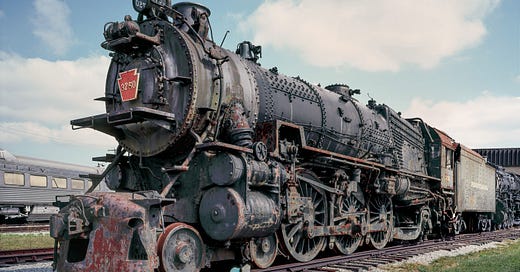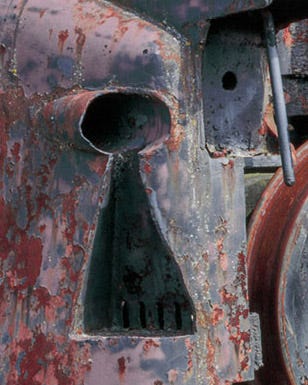Entry #19 from The Work
K4s Pacific Class Locomotive
Strasburg, Pennsylvania
60x70” pigment print from 8x10” transparency
The locomotive comes alive as the soft diffused light spreads across the scene. Exposed rivets contrast against the smooth surface of curved boiler cover. Bright detail is muted into balance with rich shadows. Crowing it all in retired majesty is a spectral, hollowed-out headlamp numbered 3750. The slightly curved track presents the locomotive’s flank in escalating scale from tender to nose. In that moment is the scene as I imagined it, an expression of static energy rendered in natural light.
Eighty years ago locomotives like the one above were steaming across the Continent. If the high brow of art welcomed trains, the one here would be included among the greatest works of sculpture. Steam locomotives embody industrial power on the one hand and humanity on the other; all those intricate parts assembled together bear witness to the personification of the functional. They were not designed to have personality, but they do. Can we say that of today’s everyday objects?
I seek to intersect the primordial current of man’s creations in providence with the nature of light. The good photographer will create a re-mapping of reality, bringing his subject into harmony with the natural elements surrounding it. In so doing he may create a true photograph, one that feels as much as it describes, interprets but does not subvert, and expresses the simple authenticity of something found.
Many photographs could be made studying the locomotive’s secondary details and minor moving mechanisms. The perfect circularity of the front pilot wheels harmonize with the three 80 inch driving wheels, and larger still boiler plate with contrasting Keystone emblem of the Pennsylvania Railroad. In eager repose are those big driving wheels connected with a side rod sitting at the bottom of the stroke. While her boiler has been cold for decades, she still seems ready for action. Many of these aggregate parts were forged single pieces of steel, such as the massive front drop pilot/cowcatcher. This shield was a late modification done in 1938 in order to modernize the-then twenty year old steel beast. Some of her four hundred sister locomotives received the upgrade as well.
This addition might be reason I see this particular locomotive as beau ideal. For in the side of this massive one piece of forged steel is a strange and roughly welded keyhole shaped cut-out. The beauty of photography is finding these “unintentional, but completely appropriate1” moments in all that inspire us. That foot step on this century old locomotive was welded together in a forgotten and long closed steel mill. Little did the worker realize that simple keyhole shape he created could punctuate all the circles, straight edges and smooth surfaces of this giant in repose.
Until next time,
“Listen more than you photograph. Describe, do not overstate. Be kind to the nature of your subjects, they speak clearer to the camera rather than to you. Get close enough so that all the important details can be seen in a 8x10” print. Do not wait more than an hour for the light, especially in the winter, the scene will change and you will have lost other opportunities. Let the photograph come to you, especially if its escaping you. In fact, let it escape you. If you’re questioning your purpose sitting your car or at rest along on a long walk, repeat out loud three times:
“Get back to work, you lazy son of a bitch!”
John Sanderson
New York City
2/10/2025
Journal introduction from The Work
The American landscape in my time. Thousands upon thousands of miles traversed in search of pictures.
They become pictures when I see something.
Something which cannot be explained in words, only related to on some level of empathy.
Feeling with the light, subject or an arrangement of the two.
Driving, walking, searching deeper and longer for that which eludes me.
What I search for is unattainable.
But what keeps me coming back is the Quest, for those moments where a picture lines up with my imagination.
It is a complete circle.
"To strive, to seek, to find and not to yield." -Tennyson
Support this writing with a subscription. Each post takes at least 2-5 hours to craft, not including making the photograph.
You will not only receive future posts but also a limited edition print of one of the images featured herein. So please consider hitting the button below:
John Sanderson, “Highway Arbor” Project Statement







